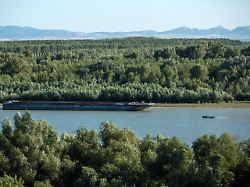From Ukraine across the Danube
Romania allows wheat transport at night
December 22, 2023, 8:55 p.m
The river administration in Romania announces that it will illuminate the Danube around the Sulina arm. This makes it possible to pass the route even at night. Romania is particularly helping Ukraine with this step.
To improve the transit of Ukrainian goods to the world, the Sulina arm of the Romanian Danube Delta is no longer only navigable during the day, but now also at night. The Lower Danube River Administration (AFDJ-RA) in Galati, eastern Romania, said the technical requirements had been created. Illuminated buoys have been provided in the water and on the banks. 18 additional pilots and a modern, digital navigation system were also made available. Work to further dredge is underway, the river administration said.
Navigating the lower reaches of the Danube requires specialist knowledge because the riverbed is not uniformly deep and ships need different channels depending on their size and load. Because of Russia’s war of aggression against Ukraine, the transport of Ukrainian wheat needed worldwide via Ukrainian Black Sea ports is being hindered. Romania’s Danube Delta is part of an alternative route that is like the eye of a bottleneck.
Difficult but essential alternative route
The ships have to navigate laboriously through winding arms of the Danube. According to the river administration, 1,823 ships sailed over the Sulina arm in the pre-war year of 2021 – in 2022 there were almost twice as many at 3,655. In the first nine months of this year the number was 3,262. Around 60 percent of Ukrainian wheat exports currently go through Romania. From the Ukrainian Danube ports of Reni and Izmail, the ships head for the Romanian Black Sea port of Constanta by traveling upstream on the Danube and then either via Sulina or via the Cernavoda canal towards the sea.
Parts of these exports also travel by rail, which was made possible after the outbreak of war in Galati by repairing the Soviet-type broad-gauge connection that had not been used for decades. The Sulina arm is the middle main arm of the Danube in its delta at the mouth of the Black Sea. Of all three main branches, Sulina is the straightest because it has been repeatedly dredged for more than a hundred years. The European Danube Commission, founded in 1856, began this regulatory process – an authority supported by the then empires of Russia, France, Great Britain, Austria-Hungary, the Ottoman Empire, Prussia and the Kingdom of Sardinia
